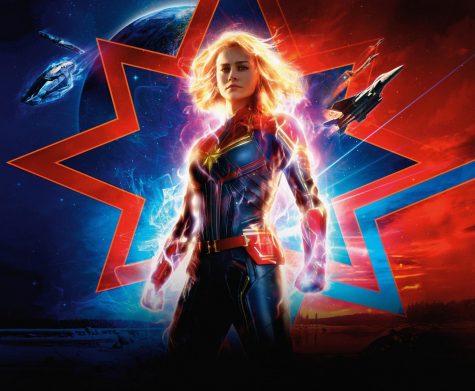Captain Marvel: a feminist 1995 science fiction joyride starring Brie Larson
March 15, 2019

Captain Marvel was written and directed by filmmaking duo Anna Boden and Ryan Fleck, produced by Marvel CEO Kevin Feige.
Captain Marvel premiered last week, and as Marvel’s first female-led solo film, it was successful. Despite online attacks about its lead actress, Captain Marvel made $455 million internationally on its opening weekend.
The film’s first act is a little stilted, but provides intergalactic world-building to Marvel’s cinematic universe. Carol Danvers (Academy Award winner Brie Larson), referred to by her alien associates as “Vers,” is stationed on the Kree planet Hala with only vague memories of her past. The audience is introduced to the Kree, an alien species heterogeneous in nature due to their imperialism. They are governed by an artificial intelligence called the Supreme Being. The plot commences when the Supreme Being sends Carol on a mission with her mentor Yon Rogg (Jude Law) and teammate Minn Erva (Gemma Chan).
Captain Marvel hits on several key science fiction markers, including alien worlds, space travel, the race for advanced technology, and the dynamics of Humans vs. the Other. The war between the two alien races of Kree and Skrull harken back to similar, classic themes in Doctor Who and Star Trek. While the Guardians of the Galaxy are a rogue unit in outer space, Carol Danvers is a soldier who is driven by duty. This film presents two sides of a galaxy-spanning struggle, neither of them purely good, but one of them clearly in the wrong. The conflict in this film is not a carbon copy of other Marvel films, and gracefully demonstrates how antagonist and ally are often two sides of the same coin.
The very first trailer opened with the scene of Captain Marvel crashing into a Blockbuster’s, establishing the film’s 1995 setting from the start. People who can remember a time pre-2005 will laugh as the film hams up the suspense with slow-download computers. Other 90s easter eggs include Altavista, Radioshack, internet cafés, pagers, and a thumbprint scanner fooled with Scotch tape.
Salt and Pepa’s “Whatta Man” makes an audio cameo, as well as “Waterfalls” by TLC and “Just a Girl” by No Doubt. The film’s setting in the recent past is an interesting move for Marvel; unlike Captain America: The First Avenger, which could be considered a period piece, Captain Marvel does not feel too far from home. It reminds the audience of how far society has advanced in the past 25 years, especially for the fictional creation of SHIELD and the actual technology of the American Air Force.
Carol Danvers teams up with Avengers creator Nick Fury (Samuel L. Jackson) in the second act of the film, creating another lovable, buddy cop-esque dynamic. Unlike previous films, Jackson (de-aged with the help of CGI) carries an easygoing demeanor and cracks several jokes. He and Larson’s chemistry perfectly fits the best friends relationship which these two have at the end of the film. Want to see tough Nick Fury cooing over a cat named Goose? This film has it. Want to know why he lost an eye? Watch the movie, and you will find that out too.
As a woman, I can say that the deliberate omission of a romance arc was refreshing. That statement is not to imply that female superheroes cannot have emotionally poignant romances with men (e.g. Wonder Woman and Steve Trevor), but writing such an arc into this film would have been a stretch. With the exception of possibly pulling in a younger James “Rhodey” Rhodes (he and Carol have a history together in the comics), Carol Danvers does not need a boyfriend in her life. In the climactic part of the film, neither she nor Jude Law’s character express any sort of romantic confession, which I admit, I was partly anticipating.
In lieu of a romance subplot, the film’s emotional core is the Rambeau family and their relationship with Carol. Maria (LaShawna Lynch) and her daughter Monica (Akira Akbar) are the reason that Captain Marvel is able to unlock her full potential. Memories of her best friend push Carol to locate her once she has landed on Earth. Larson and Lynch’s performances together are heartfelt and teary-eyed, a sharp contrast to the stone-faced Kree individuals who tell Carol to avoid feeling any emotion. In a world where women are often told that they “need to calm down” or are labeled as harpies, it empowered me to see a woman channel the power of a star with her anger, love, and righteousness.
Lynch’s Maria Rambeau excels in her own right as a single mother and an aircraft pilot during a time when women were not permitted to fly combat missions. Outside of her role as mother and best friend, Maria teams up with Fury and takes on one of the minor villains in a satisfying aerial fight. Monica Rambeau (the original Captain Marvel in the comics) gives Carol inspiration for her iconic costume. Watching Carol fly into the stratosphere, this young Black girl is most certainly a legacy. This film is a love letter to female friendships, working mothers, single mothers, women who deal with patronizing men, and women serving in the armed forces.
While discussions could increase about the film’s depiction of the American Air Force (is the US military similar to the Kree? Would Hollywood be allowed to take such a critical stance?) or Monica Rambeau’s treatment (was she snubbed? What is her future in the MCU), Marvel has pulled off another successful movie. The music is great and the special effects are breathtaking. This film gave many women an opportunity to see themselves in the most powerful character of the universe, especially in how other characters attempted to undermine her at each step of the way. 9/10, bring your friends and family.


